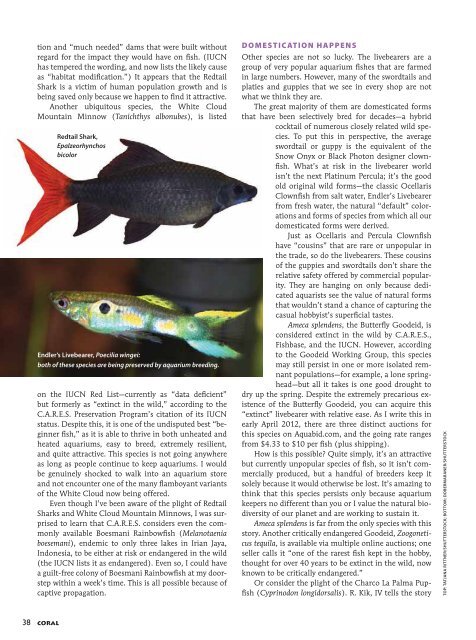Create successful ePaper yourself
Turn your PDF publications into a flip-book with our unique Google optimized e-Paper software.
tion and “much needed” dams that were built without<br />
regard for the impact they would have on fish. (IUCN<br />
has tempered the wording, and now lists the likely cause<br />
as “habitat modification.”) It appears that the Redtail<br />
Shark is a victim of human population growth and is<br />
being saved only because we happen to find it attractive.<br />
Another ubiquitous species, the White Cloud<br />
Mountain Minnow (Tanichthys albonubes), is listed<br />
Redtail Shark,<br />
Epalzeorhynchos<br />
bicolor<br />
Endler’s Livebearer, Poecilia wingei:<br />
both of these species are being preserved by aquarium breeding.<br />
on the IUCN Red List—currently as “data deficient”<br />
but formerly as “extinct in the wild,” according to the<br />
C.A.R.E.S. Preservation Program’s citation of its IUCN<br />
status. Despite this, it is one of the undisputed best “beginner<br />
fish,” as it is able to thrive in both unheated and<br />
heated aquariums, easy to breed, extremely resilient,<br />
and quite attractive. This species is not going anywhere<br />
as long as people continue to keep aquariums. I would<br />
be genuinely shocked to walk into an aquarium store<br />
and not encounter one of the many flamboyant variants<br />
of the White Cloud now being offered.<br />
Even though I’ve been aware of the plight of Redtail<br />
Sharks and White Cloud Mountain Minnows, I was surprised<br />
to learn that C.A.R.E.S. considers even the commonly<br />
available Boesmani Rainbowfish (Melanotaenia<br />
boesemani), endemic to only three lakes in Irian Jaya,<br />
Indonesia, to be either at risk or endangered in the wild<br />
(the IUCN lists it as endangered). Even so, I could have<br />
a guilt-free colony of Boesmani Rainbowfish at my doorstep<br />
within a week’s time. This is all possible because of<br />
captive propagation.<br />
DOMESTICATION HAPPENS<br />
Other species are not so lucky. The livebearers are a<br />
group of very popular aquarium fishes that are farmed<br />
in large numbers. However, many of the swordtails and<br />
platies and guppies that we see in every shop are not<br />
what we think they are.<br />
The great majority of them are domesticated forms<br />
that have been selectively bred for decades—a hybrid<br />
cocktail of numerous closely related wild species.<br />
To put this in perspective, the average<br />
swordtail or guppy is the equivalent of the<br />
Snow Onyx or Black Photon designer clownfish.<br />
What’s at risk in the livebearer world<br />
isn’t the next Platinum Percula; it’s the good<br />
old original wild forms—the classic Ocellaris<br />
Clownfish from salt water, Endler’s Livebearer<br />
from fresh water, the natural “default” colorations<br />
and forms of species from which all our<br />
domesticated forms were derived.<br />
Just as Ocellaris and Percula Clownfish<br />
have “cousins” that are rare or unpopular in<br />
the trade, so do the livebearers. These cousins<br />
of the guppies and swordtails don’t share the<br />
relative safety offered by commercial popularity.<br />
They are hanging on only because dedicated<br />
aquarists see the value of natural forms<br />
that wouldn’t stand a chance of capturing the<br />
casual hobbyist’s superficial tastes.<br />
Ameca splendens, the Butterfly Goodeid, is<br />
considered extinct in the wild by C.A.R.E.S.,<br />
Fishbase, and the IUCN. However, according<br />
to the Goodeid Working Group, this species<br />
may still persist in one or more isolated remnant<br />
populations—for example, a lone springhead—but<br />
all it takes is one good drought to<br />
dry up the spring. Despite the extremely precarious existence<br />
of the Butterfly Goodeid, you can acquire this<br />
“extinct” livebearer with relative ease. As I write this in<br />
early April 2012, there are three distinct auctions for<br />
this species on Aquabid.com, and the going rate ranges<br />
from $4.33 to $10 per fish (plus shipping).<br />
How is this possible? Quite simply, it’s an attractive<br />
but currently unpopular species of fish, so it isn’t commercially<br />
produced, but a handful of breeders keep it<br />
solely because it would otherwise be lost. It’s amazing to<br />
think that this species persists only because aquarium<br />
keepers no different than you or I value the natural biodiversity<br />
of our planet and are working to sustain it.<br />
Ameca splendens is far from the only species with this<br />
story. Another critically endangered Goodeid, Zoogoneticus<br />
tequila, is available via multiple online auctions; one<br />
seller calls it “one of the rarest fish kept in the hobby,<br />
thought for over 40 years to be extinct in the wild, now<br />
known to be critically endangered.”<br />
Or consider the plight of the Charco La Palma Pupfish<br />
(Cyprinodon longidorsalis). R. Kik, IV tells the story<br />
TOP: TATJANA RITTNER/SHUTTERSTOCK; BOTTOM: DOBERMARANER/SHUTTERSTOCK<br />
38 CORAL

















